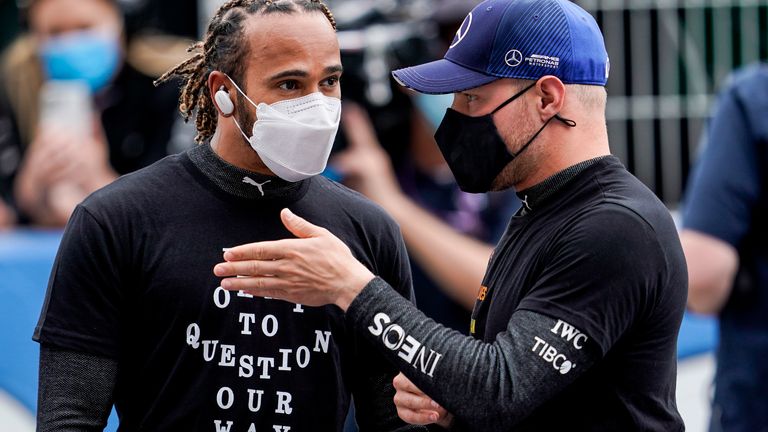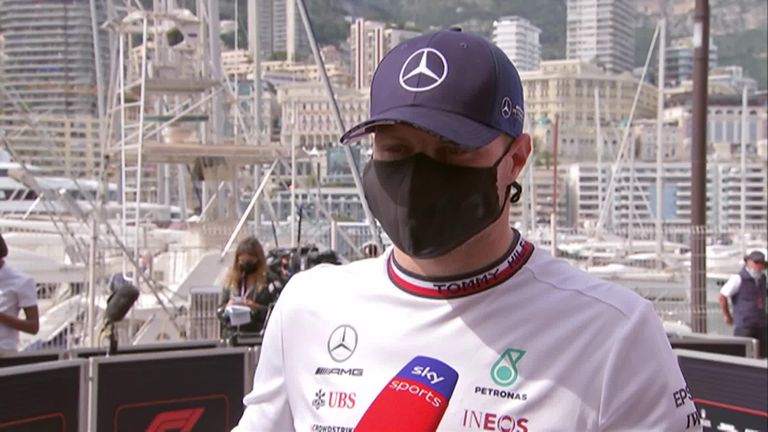Monaco GP: Mercedes explain Lewis Hamilton's lack of pace, the 'wrong' call and Valtteri Bottas' pit-stop
Why was Lewis Hamilton so slow on Saturday and Sunday? Why did Mercedes opt for the undercut in the race, and why was it 'wrong'? And why on earth didn't Valtteri Bottas' tyre come off in the pit-stop? Mercedes' James Vowles explains...
Thursday 27 May 2021 10:24, UK
Mercedes have addressed three of their major shortfalls from the Monaco GP, explaining why Lewis Hamilton struggled all weekend, the strategy call that essentially lost the world champion three positions, and the other disastrous pit-stop which ended Valtteri Bottas' race.
Hamilton lost his championship lead to Max Verstappen after surprisingly qualifying and finishing seventh at Monte Carlo, while Bottas' better pace didn't lead to any points as, dramatically, Mercedes failed to remove one of his tyres during his first stop.
In an extensive debrief video on the team's YouTube channel, Mercedes' chief strategist James Vowles detailed the reasons behind a poor weekend...
Why was Hamilton so slow?
Hamilton's performance on Saturday and Sunday was unexpected to say the least, with the Englishman - who had been in top form to start the 2021 season - struggling on his way to his worst qualifying result in almost three years and then failing to make any sort of ground in the race.
It was particularly confusing because Hamilton said he was "really happy" with his car after Thursday's opening day of practice, something Vowles backs up.
"His car was working well and the times he was setting would have put him fastest across those sessions," he says, citing traffic as the only reason Hamilton didn't head into Saturday and Sunday with the fastest time.
But Vowles adds: "As we went into Saturday, that situation inverted. Whereas Valtteri perhaps was a little bit behind him on Thursday, Valtteri was very much leading now of our two drivers."
And that's because Hamilton just couldn't get the tyres, and therefore the car to work to his liking, according to Vowles.
"On Thursday we had around 47 to 50 degrees track temperature and it cooled down significantly by the time we got to Saturday, more around the mid-30s now.
"It seems we just weren't able to get ourselves into the right working regime with the tyres and one of the drivers was just slightly happier than the other. But neither really working the tyres as effectively as we should.
"We tried a number of setup items but one of the issues that you have in Monaco is that it is a confidence builder. You need laps, you need consistent laps, you need confidence that the car is giving you everything you want out of it.
"If you can carry just a kilometre an hour or two more speed through turn one, two, three for example, you generate just another temperature level, another degree or two which then gives you more grip through the next sequence.
"Conversely, if you don't have confidence in the car and you don't trust it, you go down the spiral in the other way and you lose grip. The setup between the two cars wasn't dramatically different as we went into qualifying and race.
"Really, what had changed is just we weren't able to extract everything from the car and the tyres as we wanted anymore."
Why did Mercedes pit Hamilton first?
Hamilton was stuck behind AlphaTauri's Pierre Gasly through the opening sequence of the race, with Monaco's tight layout making overtaking difficult, if not impossible. At the end of Lap 29, Mercedes were the first team to pull the trigger on a pit-stop, trying the undercut to get Hamilton ahead on fresh tyres.
But Gasly actually stayed out and kept position, while Sebastian Vettel then leapfrogged both by staying out an extra lap. What's worse for Hamilton, Red Bull's Sergio Perez overcut all three with strong pace towards the end of his first stint.
Hamilton was irate on team radio, telling the team he was saving his tyres to go longer.
Explaining Mercedes' strategy and why they went for the undercut rather than the overcut, Vowles says: "The problem with an overcut is that doesn't exist until Gasly stops.
"He has to stop to present an opportunity for us to have free air in front of us. He already had a gap to traffic behind, the same gap that we put Lewis into and he wasn't taking it, which means he wasn't terribly convinced that they had to stop first, they were waiting for us to stop. I am fairly confident had we waited a lap or two they still wouldn't have stopped.
"That now meant that we had an opportunity, we can wait and hope that perhaps something happens to his tyres or a situation takes place, or we can take the prerogative and go for the undercut.
"We had a fear that waiting with Lewis and waiting another two laps would just put us into a situation where that gap actually got worse to Gasly."
Vowles adds that "on our calculations, we should have come out just ahead of him" and that "it wasn't an easy undercut, but it was an achievable undercut". Gasly, however, emerged on-track 0.2s ahead of Hamilton.
"It was incredibly tight and close but we were wrong, we didn't undercut," he says, again citing problems with the tyres. "The difficulty of warming that Hard tyre on the out lap was such that we didn't complete it."
On Hamilton and whether he could have gone much longer, Vowles continues: "I think we could have done a couple more laps but certainly we wouldn't have done 10 more."
What happened to Bottas' pit-stop and how can Mercedes avoid it happening in the future?
One of the most dramatic moments of the race, and indeed one that will long pain the team, was when Bottas pitted from second place - only for Mercedes to fail to remove his front right soft tyre.
The team said soon after that the "wheel nut machined onto the axel", essentially meaning that the wheel gun's force sanded the wheel nut smooth rather than connecting to the teeth. Vowles says this was due to the wheel gun being applied on the nut at the slightly wrong angle.
"The gun is an incredibly powerful gun, such that you can actually see the mechanics having to restrain themselves holding themselves to the ground otherwise they get rotated with it at the same time," says Vowles.
"It's an impact force and what happens is the nut typically loosens in four or five impacts against it. A hammering action.
"Now, what happened is we came on slightly angled, so when the socket was now connected to the nut, it slightly angled relative to it and as a result of that, now instead of distributing the load across all of the nut, it was across a small section and that tore the metal clean off and in fact, all of the metal was now removed from the nut.
"As a result of that, the nut was in place and we were unable to remove it."
The issue was so severe that Mercedes were unable to remove the tyre in Monaco and we intending to do so back at the factory.
"Clearly, it's a circumstance that cost Valtteri dearly and cost the team dearly and one that we are going to put steps in place to mitigate," says Vowles.






